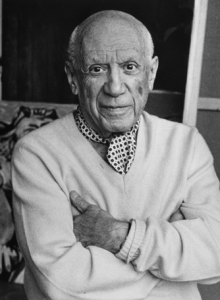
Pablo Picasso didn’t follow rules—he rearranged them.
Born in Spain in 1881, Picasso could draw before he could talk. By age 14, he was outdrawing adults. By 15, he won Spain’s top art prize.
Then… he broke every rule he’d learned.
He didn’t just change his style.
He changed art itself.
That’s why he’s one of our 35 master artists.
From realism to Cubism, Picasso showed the world that art didn’t have to look “real” to feel true.
He painted blind men, sad guitarists, circus performers, and women with two views in one face. He saw emotion in color. He saw movement in still life. And he painted music like it was a puzzle.

That’s what your students will explore.
They’ll study Picasso’s four famous styles:
- The Blue Period (sad, cool colors, lonely figures)
- The Rose Period (warmer, happier, with circus characters)
- Cubism (all angles and views at once—like a mixed-up puzzle)
- The Classical Period (inspired by Greek statues—smooth and rounded)
And they’ll practice:
- Right-brain drawing to flip their perspective
- Using bright chalks and bold black lines
- Creating Cubist-style instruments that bend reality
- Layering color with tissue—no brush required
- Exploring line, shape, balance, and composition in new ways
The best part?
Each lesson is built for success:
- No prior art experience needed
- Easy prep with clear supply lists
- Step-by-step “Working With” guides for all levels
- Scripts and visual aids for teachers, staff, or volunteers
- And flexible options—digital or onsite
Already teaching Picasso in your classroom? Consider trying a new level or pairing with music class. Haven’t added him yet? You can buy just the Picasso unit—or go all in with the full track.
Either way, your students will leave saying, “That’s my Picasso!”
Want to see what other students created after studying him?
Visit our Student Gallery and enjoy some mixed-up, musically inspired masterpieces.
Let’s break the rules—beautifully.
Creatively yours,
Meet the Masters
Inspire – Educate – Create
Dig Deeper:
